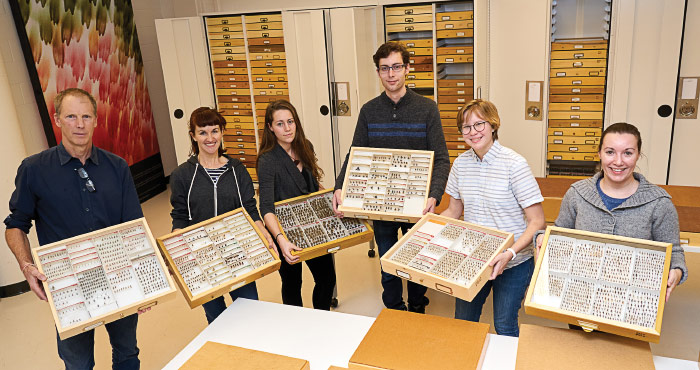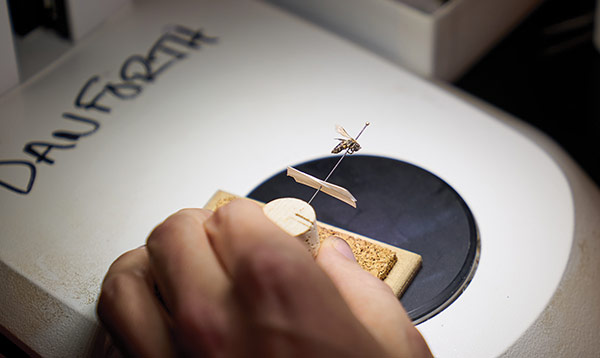Our Indispensable Pollinating Bees
 |
|
The Danforth lab recently finished a 10-year study on bee diversity in New York State apple orchards. Photo by Dave Burbank. |
By Jackie Swift, writing for Cornell Research (research.cornell.edu)
Bees are big news these days. The internet is full of stories about colony collapse, where hives of domesticated honey bees die off en masse. If the honey bee disappears, the current wisdom goes, crops won’t get pollinated. Is this really true? There are 20,000 bee species in the world—4,000 of them in the United States and an estimated 420 in New York. Amongst all the bees out there, who is really doing the pollinating?
“My perspective as a wild bee specialist is that there are so many wild bees, maybe we should be trying to understand their role in agricultural crop pollination,” says Bryan N. Danforth, professor in the Cornell University Department of Entomology.
New York State’s Bee Diversity
The Danforth lab recently finished a 10-year study on bee diversity in New York State apple orchards. Contrary to the belief that honey bees are essential to pollinating crops, they discovered wild bees vastly outperform honey bees on a per-bee basis. Danforth’s collaborator Mia Park—who earned a PhD in entomology from Cornell in 2014—found that wild bees deposit four times more pollen grains per visit than honey bees do.
“Honey bees are terrible pollinators,” Danforth says. By videotaping the bees, the researchers discovered that most honey bees visiting a blossom suck up nectar at the base of the anthers, the pods that hold the pollen in a flower’s stamen, rather than actively collecting pollen as wild bees do. As a result, honey bees don’t pick up much pollen, and they don’t come in contact with the stigma, the female part of the flower, to pollinate it.
“We did a lot of outreach to apple growers as a result of this project,” Danforth says. “Our message was, ‘You probably don’t need to rent honey bees unless you have a very large orchard. You can probably rely on the native bees for much of your apple pollination needs. Conserve your natural habitat around the orchard where the wild bees live because it’s going to benefit your bottom line.’”
Social Bees versus Solitary Bees

Photo by Dave Burbank. |
|
We may think of honey bees as the quintessential bee, but Danforth is quick to point out that they aren’t typical. For one thing, honey bees are floral generalists. “Honey bees will go to almost any host plant for pollen and nectar,” Danforth says. “Many other bees are very highly specialized. They visit a single host plant species for their pollen and nectar. If their preferred host plant disappears, these pollen-specialist bees will likely go extinct as well.”
Of all the bee species in the world, only about 10 percent are social like the honey bee, living in colonies with many workers and offspring. Most (75 percent) are solitary, where a single female gathers pollen and nectar for her offspring, occupies the nest, and lays her eggs—often as few as a dozen. Another 15 percent of bees are brood parasitic. They lay their eggs in the nest of another bee species, and their larvae then kill the host larvae and consume the provisions meant for them.
“Biologically, bees are fascinating and diverse,” Danforth says. “They arose from wasps, which are carnivores. But sometime in the Cretaceous Period, about 125 million years ago, the ancestors of bees switched from a carnivorous diet to an herbivorous one. That was a key innovation. It probably drove the rapid diversification of bees in the mid-Cretaceous.”
Bee Phylogenetics
 |
|
Photo by Dave Burbank. |
A big part of the Danforth lab’s research focuses on the phylogeny of bees—their evolutionary history—using large data sets with thousands of genes to try to understand the evolutionary relationships among bees and between bees and other organisms. In particular, the researchers are interested in how bee phylogeny relates to that of their closest wasp relatives. “We can use phylogenetics to understand lots of things about bee biology, like the evolution of social behavior, host plant use, and parasitism,” Danforth says.
“We can go back in time and reconstruct what an early bee might have looked like within any particular lineage of bees.”
The researchers construct phylogenetic trees, then use them for further study, such as tracking how host plant associations of certain specialist bees changed over time. “We map onto a phylogeny of bees the host plant each bee species is visiting,” Danforth explains. “Then we ask, ‘What was the ancestral host plant that the ancestor of those bees was visiting?’ We can also reconstruct ancestral states. In a sense, we can go back in time and reconstruct what an early bee might have looked like within any particular lineage of bees.”
At the Museum of the Earth
“We can go back in time and reconstruct what an early bee might have looked like within any particular lineage of bees.”
– Bryan Danforth, professor, Cornell University Department of Entomology
Danforth’s phylogenic work is getting air time at a new exhibit on bees, which opened in October 2019 at the Museum of the Earth in Ithaca, New York, Cornell University’s hometown. The exhibit was funded as part of a research grant by the National Science Foundation (NSF).
“The focus is to highlight unfamiliar aspects of bee biology,” Danforth says. “We don’t talk about honey bees or the bumble bees in your backyard. Instead, we emphasize the biology of some lesser-known but truly remarkable bees, such as bees that build nests in snail shells, bees that forage by the light of the moon, and highly specialized bees that collect floral oils—all the really interesting stuff most people don’t think of when they think of bees.”
Documenting New York State Bees, and Other Bee Projects
Danforth is also collaborating with the New York Natural Heritage Program on the Empire State Native Pollinator Survey. Funded by the State of New York, the project will document all 420 species of bees in the state to determine the status of their populations. A main focus of the project is to understand which species are threatened or in decline and identify the likely causes.
Recently Danforth has begun a new project, funded by the United States Department of Agriculture and the NSF, to look into another startling discovery made by Mia Park during the apple orchard project. Park found that fungicides have a bigger impact on the community of orchard pollinators than insecticides do, even though fungicides have low direct toxicity for adult bees. Danforth and his collaborators theorize that fungicides might be impacting the microbial communities in the pollen provisions collected by females for their offspring. “There’s an enormous diversity of microbes in these pollen provisions,” he says. “We’re just starting to appreciate how important they are to larval development.”
In all his research, Danforth is driven by his admiration for the under-appreciated solitary bees. “They’re fascinating and many of them are beautiful,” he says. “And I think we’ve completely underestimated how much they contribute to our crop production. We haven’t quantified the value of these unmanaged bees. Let’s stop giving all the credit for crop pollination to the honey bee, and let’s try to find out how much pollination is provided—for free—by wild bees.”
This article first appeared on the Cornell Research website, at research.cornell.edu/news-features/our-indispensable-pollinating-bees, and is reprinted with permission.
Due to shutdowns imposed in response to the COVID-19 pandemic, an online version of Bryan Danforth’s Museum of the Earth exhibit has been made available at www.museumoftheearth.org/bees.
Since this article was first published, Danforth co-authored a book, titled, The Solitary Bees: Biology, Evolution, Conservation. It contains a chapter on the role of wild bees as crop pollinators, which outlines the evidence that wild bees are economically important pollinators of many of our high-value crops.
For more information, see press.princeton.edu/books/hardcover/9780691168982/the-solitary-bees.
The Northeastern IPM Center promotes integrated pest management for reducing risks to human health and the environment. If republishing our news, please acknowledge the source (“From Northeast IPM Insights”) along with a link to our website.
